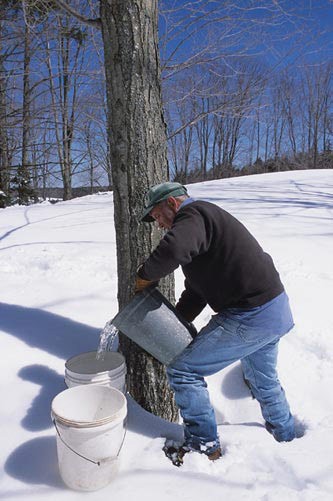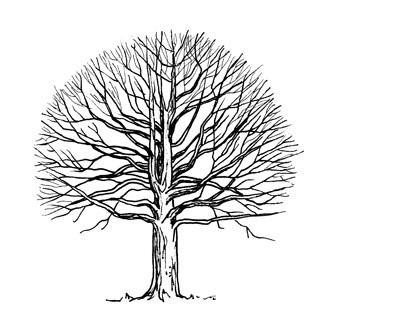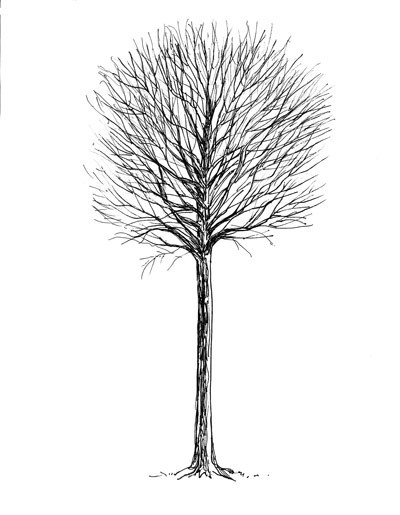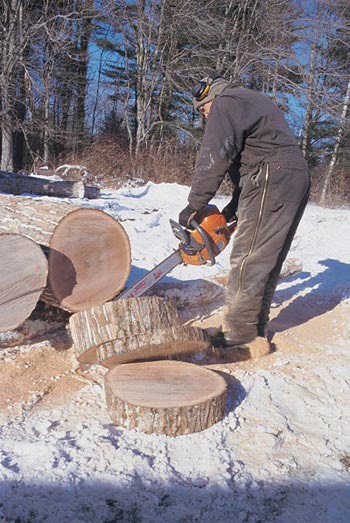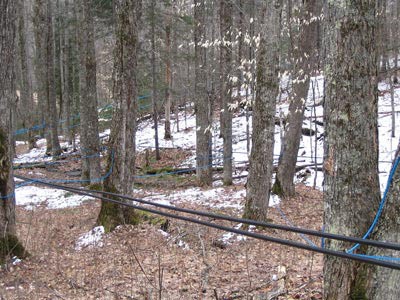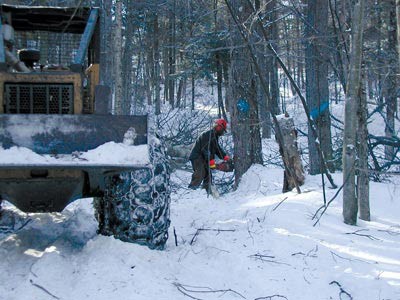When visitors arrived at Ed Lanigan’s 309-acre tree farm in Alton, New Hampshire, he waved them over to a row of sugar maples he had tapped a couple of weeks earlier. The March breeze had a chill to it, but that didn’t bother him. He grinned as he lifted the cover off a sap bucket, revealing a great run from the day. It is Lanigan’s enthusiasm, warmth, and interest in sugaring that bring friends and neighbors to his tree farm, where they watch great billows of steam rise from the evaporator and purchase pints of fresh maple syrup.
Every spring, in sugarhouses across the region, people are hypnotized by the steam, smell, and process of making maple syrup. Many find themselves seduced, convinced that they should join the ranks of sugarmakers and tap some maples on their own property. But since maple trees are a valuable timber species, anyone who wants to drill holes into their trees must first consider the financial implications of the act. How does a landowner decide whether to tap a tree or grow it for timber? And can you do both?
There are some similarities in managing your woods for timber or for sugaring. In both timber and sugarbush management, a primary goal is to favor vigorous, fast growing, well-formed trees with healthy crowns. In a dense stand of trees, with either objective, a landowner should remove the poorest-quality trees (forked trunks, damaged crowns, obvious rot), allowing the remaining trees to thrive by occupying more space and capturing more sunlight and nutrients.
But the similarity ends there. A well-managed sugarbush will feature mostly maple trees; the trees themselves will have large crowns and short trunks. To achieve this, aggressive thinning is often necessary so that light can reach the lower branches. Well-formed trees that may one day grow up to be quality sawlogs will have to be sacrificed. An ideal timber stand, on the other hand, will be more highly stocked; that is, the trees will be more densely spaced. The trees will have smaller crowns and long, self-pruned, straight trunks with little taper, and there will be greater species diversity.
Is it possible to manage for both? Yes, but there are inherent trade-offs. In a stand that is stocked for timber growth, some sugaring value will be compromised because the individual maple crowns do not have enough space to fully develop, capture the most sunlight, and produce the maximum amount of sugar. If other tree species are also present in the timber stand, the sugaring potential is further reduced.
The timber value, meanwhile, is reduced the moment you bring out the drill and pierce the tree. Taps are placed in what would be the first sawlog (lower 16 feet of the stem). After a tap is removed, the hole will cover over in one to three years in a healthy tree. It will, however, leave a residual scar above and below the taphole that reduces the potential sawtimber value of the tree when it is cut and manufactured into boards. When approaching a maple tree with a drill in hand, the financial tradeoff is the annual return from maple sugaring as opposed to the marginal difference in the value of the first sawlog before and after it is tapped.
If you’re managing your woodlot for the highest economic return, you shouldn’t tap trees with veneer potential. Veneer logs, which are perfectly straight and completely free of defects, can demand $2,000 or more per 1,000 board feet (MBF). These logs aren’t sawn to make boards; they’re peeled on a lathe or sliced into thin sheets of wood. For this reason, even the slightest defect devalues them.
If the stumpage value of a mid-quality veneer sugar maple log is $2,000/MBF, a butt log of 140 board feet will have a value of $280. Once the landowner taps it, it becomes sawtimber and not veneer; the value of that butt log drops to $42, assuming a price of $300/MBF. In exchange for that loss of $238, the landowner could put two taps in it each year, expend a lot of time and energy, and gross somewhere between $20 and $40.
Even though most landowners would like to think otherwise, veneer logs are not that common, usually constituting no more than 5 or 10 percent of a total timber sale volume, and many woodlots have no veneer logs growing on them. If your maples are less than perfectly formed, tapping may yield the highest rate of return; there may be little harm in tapping a tree that has already been valued as low-grade sawtimber or pulpwood, and in such cases, sugaring could eventually produce a higher financial return.
Some higher-value sawlogs can be removed immediately or over subsequent decades when they are financially mature, when it benefits the sugarbush, or when it benefits the residual stand. By simply flagging the veneer trees as off limits, and then tapping the other maples in the bush, a sugarmaker can have his cake and eat it, too.
An Investment of Labor
When considering whether to manage your maple stand for sugaring or timber, it’s important to note the differences in the nature of the investments. Producing maple products is a labor-intensive business providing an annual return, while growing timber is an investment aimed at long-term appreciation and a deferred return. Both are subject to widely fluctuating market conditions and, as any landowner knows, there are both financial and emotional returns to be considered.
In 1999, Ed Lanigan established a small sugaring operation. Despite owning over 300 acres, the soils, species composition, and his own land-management objectives dictated a small-scale operation. Ten percent of his acreage had sugar maples growing on it, and most of them were at the base of a moderate slope close to his house and existing access roads. As a fulltime engineer, Lanigan wanted to be realistic about his time commitment; he tapped the most accessible trees along the roadside and his backyard, keeping the operation under 100 taps.
Like so many individuals getting involved in sugaring for the first time, he was not motivated solely by profit; nonetheless, he tried to maximize the profitability of his venture by keeping costs down. He purchased all the supplies that he needed for under $1,000 and built his own evaporator.
Total production the first season was approximately 15 gallons, which today would be worth around $30 per gallon if sold in bulk (retailing syrup involves extra work packing and marketing, but it can significantly increase a sugarmaker’s return). He used 1–1½ cords of wood and spent countless hours, often Thursday through Sunday, boiling down the sap he collected during the week.
Lanigan’s experience illustrates the conundrum facing small-scale producers. On one hand, there is a strong sentiment in support of sugaring: “We have people who come up every year and want to see us do it. It’s fun. A lot of people enjoy it,” he said. Unfortunately, that sentiment cannot be willed into a meaningful financial return. When Lanigan evaluates the financials, he candidly states, “If you don’t include my time, I make money. If you account for time and wood, I make about 11 cents an hour doing this.”
As a general rule, smaller producers, defined here as operations with fewer than 1,000 taps, have a difficult time being profitable if labor costs are taken into account. A small hobby operation can gross $4.50 per tap, while a highly efficient commercial setup could gross $15 per tap.
Owners of larger operations can achieve economies of scale, investing in efficient technology such as reverse osmosis, preheating systems, larger evaporators, vacuum systems, and oil burners. By making capital investments in their operation, landowners assume greater financial risk. In return, these operations are more profitable on a per tap basis. In pursuing a viable commercial operation, the small-scale producer should be careful not to inadvertently over invest and still not achieve a scale that justifies the investment.
An Alternative to Making Syrup
Peter Rhoades, a forester and sap producer on 275 acres of land in Alstead, New Hampshire, has a 3,000-tap operation. He developed a profitable business model in which he sells sap rather than taking it to the next step of manufacturing syrup, and this market niche meets his personal goals. “My interest was in being a forester, working out in the woods with the taps and with the tubing systems, instead of being tied up in the marketing of syrup and such,” Rhoades said.
In 1972, Rhoades took over his family’s smallscale sugaring operation and has expanded it dramatically. Recognizing the exhaustive labor required in large-scale bucket collection, he shifted his operation toward a tubing system and retired his last bucket in 2008. Originally, Rhoades had plans to boil sap into syrup. He was going to size and locate his sugarhouse after he finalized the number of taps, or total amount of land that he was going to allocate for sap production. Ultimately, he decided the potential return on investment for a sugarhouse did not justify the risk; the required scale for a profitable operation was larger than he wanted to take on.
In Rhoades’s forest, most of the maples have been tapped already, so any previously tapped tree – of high or low value – is managed for sugar. “Once you drill the first hole, there’s no decision from that point on,” he said.
There are some stands that haven’t been tapped, and in these areas, each tree is evaluated on its merit as a potential sawlog. If it has good sawlog potential, he doesn’t tap it.
Lanigan’s and Rhoades’s stories illustrate important considerations for anyone contemplating a venture in commercial sugaring. There needs to be enough production or efficiency to be profitable. Lanigan said, “When I realized that I was not making any money, I tried to figure out what was going wrong. It turned out I was doing everything right.” Making a profit often requires significant capital investment in each stage of sugaring (sap production, evaporation, packaging, and retailing). The decision to establish a small commercial operation should be founded on knowing the financial tradeoffs of each management option: not tapping at all, tapping some maples, or tapping all the maples of a tappable diameter in a stand.
A commitment to sugaring is a commitment for the life of the equipment. As Rhoades explains, “With timber, you can time the harvest to the market. Once you buy equipment for sap production, the depreciation cost is the same every year, so you have to use it.”
Once you have made the decision to tap, you are at the whim of the market price. The market may be generous and work in the sugarmaker’s favor, as it did in 2007 and 2008, when Rhoades saw a 44 percent increase in maple sap prices and a 16 percent decline in the stumpage of sugar maple sawtimber. Alternatively, maple sap prices may remain flat, as they did for Rhoades for 18 years between 1987 and 2005, when he saw the real value of sap plummet more than 50 percent. Sawlogs, of course, are not immune to dips in the market. In the last three years, the prices paid for sawlogs have plummeted, and that $42 sawlog mentioned above would now bring $32.
Ultimately, landowners need to find an investment – timber, sugaring, or other – that meets their goals while assuming an acceptable financial risk. While most people would find it hard to manage a 2,000-tap sugarbush and maintain a full-time job, there are thousands of smaller, hobby-style operations across the Northeast. And each spring, as the steam billows from the sugarhouse, those sugarmakers will look beyond mere dollars when calculating their return on investment.


